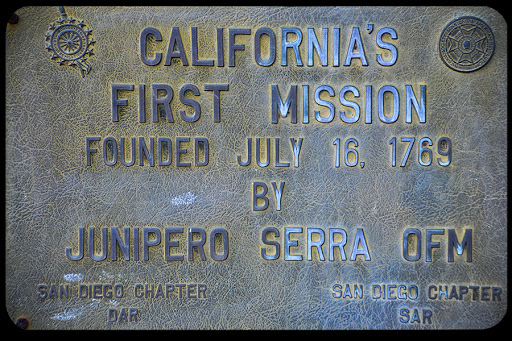FROM THE ARCHIVES
Unlike many other American saints and beati, Blessed Junipero Serra has received an unprecedented amount of press since his beatification by Saint John Paul II in 1988. Honored as the man credited with founding the Franciscan Missions of California, his reputation and legacy have also been tainted by recent critics who claim that the missionaries—and Serra in particular—used violent tactics against the native population in efforts to force conversions to Christianity and suppress indigenous cultures.
Pope Francis’ decision to canonize Padre Serra during his upcoming visit to the United States has reignited debate over the friar’s mission, particularly in these days when questions of racism and civil rights form so much of our national conversation. However, during a recent Mass celebrated in Serra’s honor at Rome’s North American College, Pope Francis effectively addressed these criticisms when he praised Serra as being among a number of missionaries who “brought the Gospel to the New World, and, at the same time, defended the indigenous peoples against abuses by the colonizers.”
Who was Junipero Serra?
Jose Miguel Serra was born on the island of Mallorca (Spain) in 1713. In 1730, he entered the Franciscan Order, receiving the name Junipero. After his ordination to the priesthood in 1737, he was awarded a doctorate in theology and spent a number of years teaching philosophy at the University at Palma de Mallorca.
In 1749, he sailed to “New Spain” and, for nearly ten years, traveled throughout Texas and Mexico, preaching and serving in a variety of administrative positions. In 1767, Serra was chosen padre presidente of the missions of Lower California and, in 1769, he founded the first mission of Upper California at San Diego, serving as superior of the Franciscan friars and of the missions themselves. In the years that followed, he established nine other missions throughout California. During a 1987 visit to the Basilica of Mission San Carlos in Carmel, California, Saint John Paul reflected:
While Padre Serra followed the traditional methods for administration of the missions, the early efforts of the missionaries bore little fruit. In the early years, two friars were assigned to each mission and Serra was insistent that, while Spanish would be the common language, the friars learned the language of the area in which they served; in some missions catechisms were translated into the local language.
Serra and the friars frequently came into conflict with military officials and soldiers assigned to each mission. The close relationship of the missions to the military praesidios led to numerous instances of abuse, exploitation, drunkenness, and rape, all of which threatened to undermine the friars’ work and the future of the missions. In an effort to ensure the protection of the local populations, Serra twice traveled to Mexico City and succeeded in having a series of initiatives approved by the colonial governor. This “bill of rights,” known as the Representación, sought to limit the influence of the soldiers in the work of the missions, particularly focusing on the physical and spiritual well-being of the native populations. Under Serra’s administration, the missions eventually flourished and it is believed that some 6,000 Native Americans received the Sacrament of Baptism.
Blessed Junipero Serra died in Monterey, California, on August 28, 1784. His commemoration is celebrated in the United States on July 1. He will be canonized by Pope Francis on September 23.
Serra’s Vocation
Junipero Serra was first and foremost a missionary. He recognized that the Gospel was a matter of life and salvation. Serra and his fellow missionaries “believed that in offering people Jesus Christ, they were doing something of immense value, importance, and dignity” (Saint John Paul II). In this sense, Serra was a true pastor. His primary concern was for the welfare of the friars and the converts. Sadly, in the decades after Serra’s death, the missions went into rapid decline, particularly after they were secularized and the government assumed control of both the missions and their inhabitants, increasing a process of exploitation and abuse against which Serra had fought so strongly.
Although his efforts and the Spanish friars’ “paternalistic” attitude toward the new Christians (including strict rules and the use of corporal punishment) is an affront to our contemporary sensibilities, we can’t allow this to eclipse the sacrifices and motivations of both those early friar-missionaries and their native converts.
But to limit our understanding of Blessed Junipero and his Franciscan collaborators to sound bites and polemics is to ignore the overwhelming charity and personal holiness exhibited by this tireless missionary. “Our purpose was to attempt,” he wrote, “each in his place, to win for his Most Holy Majesty, a multitude of souls.” And, as a pastor of a “multitude of souls,” time and again Serra’s words and actions reveal a father’s care for his children. Archbishop José Gomez of Los Angeles reflected on this, when he said,
All of his writings reflect genuine respect for the indigenous people and their ways. It is sometimes said that Father Serra was a “man of his times.” But to tell the truth, he really wasn’t. He was far ahead of his times…
Father Serra rarely used the ordinary terms used by colonial authorities and the society of his time—words such as “barbarians” or “savages.” Instead, he referred to the native people as “gentiles”—using the biblical term for those who do not yet know the living God…He loved his people with a father’s love. Father Serra once wrote: “They are our children, for nobody except us has engendered them in Christ. And so we look upon them as a father looks upon his children”…
But at the heart of everything Father Serra tried to accomplish every day was his conviction that the indigenous peoples of the New World were children of God, created in his image and endowed with God-given rights that must be promoted and defended.
Finally, it is worth noting that, in all his efforts, Junipero Serra trusted his “children” to the maternal care of Mary, Our Lady of Guadalupe. In 1750 he had walked barefoot from Vera Cruz to her shrine in Mexico City, to dedicate his mission vocation to her service.
The Legacy of Blessed Junipero Serra
In a very real sense, the great legacy that Serra offers us today is his evangelical witness. Both Saint John Paul II and Pope Francis have praised Serra’s untiring apostolic zeal, recalling that his efforts reflect the primary vocation of the Church and each Christian: the proclamation of the Gospel.
In his homily at the North American College, Pope Francis asked if we, today, “are able to respond with the same generosity and courage to the call of God, who invites us to leave everything in order to worship him, follow him, to rediscover him in the face of the poor, to proclaim him to those who have not known Christ, and therefore, have not experienced the embrace of Mercy.” The great missionary saints—including Junipero Serra—challenge us to move to the periphery to share the message of Christ’s saving power with those who have been overlooked or left behind. This common mission requires a true level of personal involvement from each member of the Church, especially in the care of the poor. In
Evangelii Gaudium, Pope Francis reminds us:
Finally, even the historical challenges posed by life in the missions and the lingering “black legend” that corrodes Father Serra’s reputation provide a powerful reminder for each of us as we pursue holiness: sanctity and perfection are not the same thing. For those saints who challenge our perspectives on holiness and perfection, we owe a debt of thanks. They remind us that the Christian life is a movement from good to better, not good to perfect, or even to “best.” We are to strive for holiness, yes, but each of us struggles against the drives of our human nature and the perspectives and limitations of our own time and place. Junipero Serra lived a life that was always moving toward the fulfillment of his missionary vocation and his own growth in holiness.
Times move on and the practices and perspectives of past generations evolved. We ourselves have wars, violations of human rights, lingering racism, and theological tensions. But these also reveal that our generation is dynamic, moving toward a future point whose own generations will judge us based on our care (or lack thereof) of the poor, the sick and vulnerable, the migrant, the refugee, and the environment.
In the end, the Blessed Junipero Serra deserves our gratitude and devotion. His unswerving devotion to his missionary vocation and unwavering concern for his small and scattered flock challenge us to look beyond the boundaries of our families and parishes, inviting us to live out our call the share the Good News and work for justice for all God’s children.

